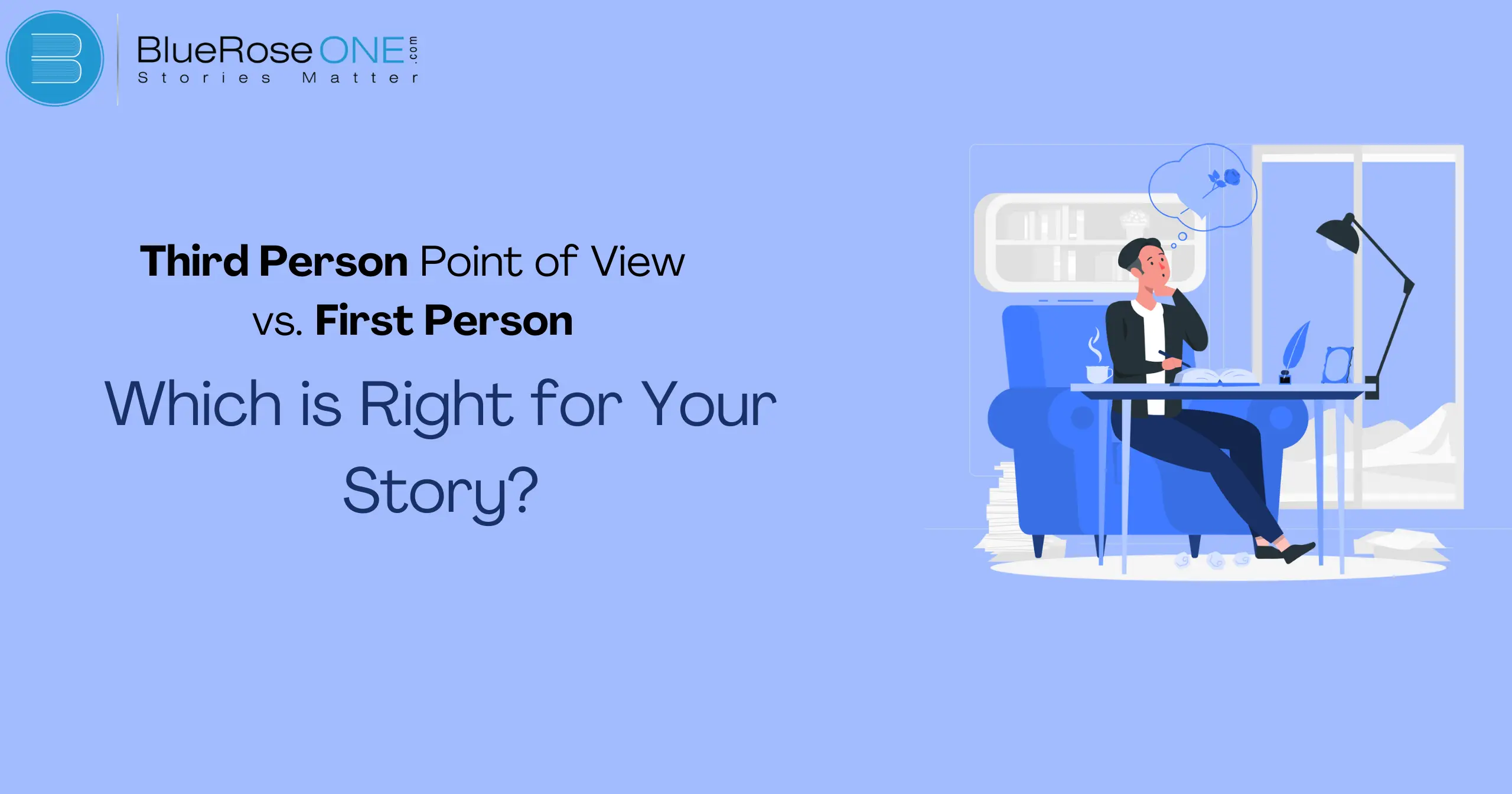In narrative, selecting the appropriate point of view (POV) is essential. It influences how readers relate to and interact with your story and characters. First-person and third person point of view are still up for dispute, and each has advantages and disadvantages of its own. Thus, how do you choose which is appropriate for your narrative? Now let’s go specific.
Understanding Third Point of View in Writing
In writing, point of view establishes whose viewpoint is used to tell the story. It serves as the prism through which readers interpret the story, the scene, and the characters. While the incorrect decision might lead to confusion and distancing, the correct POV can increase the impact and immersion of your story.
What is a Third Person Point of View?
Third person POV uses pronouns like “he,” “she,” and “they.” It offers a perspective outside of any one character, providing a broader view of the story. There are three main types of third person POV:
Omniscient
In the third person point of view, the omniscient narrator knows everything about every character, including their thoughts and feelings.
This allows the reader to see the story from multiple perspectives, providing a comprehensive understanding of the plot and characters.
The omniscient viewpoint can create a rich, detailed world, making it easier to convey complex narratives. This contrasts with the first person, which offers a more intimate but limited perspective.
Limited
A third-person limited point of view provides a narrow viewpoint because the narrator is privy to the thoughts and emotions of a single character.
This viewpoint preserves the reader’s distance from the action while allowing them to empathize fully with a single character. It helps foster empathy and suspense without giving away too much about the other characters. The intimacy of first-person tales and the wider reach of third-person omniscient narratives are balanced by this strategy.
Objective
The narrative is told from an objective third-person point of view, which conceals the protagonists’ innermost feelings and ideas.
Rather, the emphasis is on discernible behaviors and conversations, enabling readers to deduce feelings and intentions. This viewpoint produces an objective, dispassionate story that is perfect for preserving mystery or letting readers draw their own conclusions.
The objective third person provides a wider, more unbiased viewpoint of the story’s events than the first person, which emphasizes the narrator’s personal perspective.
You may also like: What is Typesetting? A Beginner’s Guide to Perfect Page Layout
Advantages of Third Person Point of View
Broader Perspective
The third person point of view has several advantages, one of which is its wider viewpoint. By sharing the ideas, emotions, and experiences of numerous people, the narrator is able to provide the reader a more thorough grasp of the narrative.
It facilitates readers’ comprehension of various plot points and helps them grasp the larger picture. Authors can craft a more sophisticated, deep, and immersive narrative by employing the third person point of view.
Flexibility in Narrative
The third person point of view has several advantages, one of which is its narrative versatility. This viewpoint enables the author to flip between characters’ points of view, offering the reader a more comprehensive comprehension of the narrative.
The third person point of view can enhance the reader’s experience by providing different perspectives and a more in-depth understanding of the plot and characters than the first person, which is restricted to the viewpoint of a single character.
Greater Scope for World-Building
Using the third person point of view offers greater scope for world-building in a story. This perspective allows the author to describe multiple settings and events happening simultaneously, providing a fuller, richer picture of the story’s universe.
By not being limited to a single character’s experiences and knowledge, the third person point of view can explore diverse locations, cultures, and backgrounds, making the narrative more immersive and detailed for the reader.
You may also like: A Compelete List of Anuja Chuahan Books
Disadvantages of Third Person Point of View
Potential for Distance from Characters
One drawback of third-person point of view is the possibility of character distancing. Third person tales can evoke a sense of isolation, in contrast to first person narratives where the protagonist expresses their ideas and feelings directly.
Because emotions and perceptions are filtered through an external narrator, readers may not feel as deeply linked to the inner worlds of the characters.
This may occasionally make it more difficult for readers to completely comprehend and relate to the motivations and experiences of the characters, which may have an effect on how emotionally invested they are in the narrative.
Risk of Head-Hopping
Third-person point of view has some benefits when writing, but there are drawbacks as well, such as the possibility of head-hopping. When the narrator alternates between the perspectives of several individuals in a single scene or paragraph, it’s known as head-hopping.
This may cause readers to become lost in the narrative and hinder their ability to empathise with the characters more deeply. To prevent this problem and preserve a seamless narrative experience, authors who use the third person should make sure that their point of view is clear and consistent.
Complexity in Maintaining Consistency
When writing, it can be difficult to keep the third person point of view consistent throughout the narrative. This intricacy results from the narrative’s external point of view, which describes characters and events from the perspective of an observer rather than from the characters’ own point of view.
In order to avoid unintentionally confusing readers, authors must make sure that details regarding characters’ thoughts, feelings, and actions stay logical and in line with the perspective they have selected.
When employing third person point of view in storytelling, it’s important to strike a balance between rich descriptive details and coherent storytelling.
You may also like: Latest Sahitya Akademi Award Winners List (Updated)
What is the First Person Point of View?
First person point of view uses pronouns like “I” and “we.” The story is told directly from a character’s perspective. There are two main types:
Reliable Narrator: An authentic narrator narrates the story directly in the first person, using the pronouns “I” or “we.” By sharing ideas, emotions, and experiences, this narrator provides a personal viewpoint. Readers must have faith in the narrator’s veracity and honesty in narrating events.
A trustworthy narrator enhances the reader’s comprehension and involvement with the story by presenting events impartially and without purposeful deception.
Deep access to the narrator’s inner world is made possible by this viewpoint, which also offers insights that may influence how the reader interprets the story.
Unreliable Narrator: An untrustworthy narrator in a first-person point of view can significantly affect how the story is understood. The narrator, who is frequently a character in the narrative, describes the events according to their own opinions, viewpoints, or even willful lying.
This viewpoint may cause readers to doubt the story’s veracity and their comprehension of the plot and characters. This technique is employed by writers to explore themes such as perception versus reality, deepen characters, and build suspense.
It is important to comprehend how an untrustworthy narrator affects narrative in order to contrast it with the third-person point of view, which offers more objective perspectives.
You may also like: The Rise of Shakti by Megha Dinesh: Book Review
Comparing Third Person and First Person Point of View
Flexibility and Control
The two main points of difference between first- and third-person perspectives are control and flexibility. Third-person point of view gives the author greater freedom to switch between characters and events, giving the reader a more comprehensive understanding of the narrative.
Additionally, the writer has more influence over the story from this point of view, which makes it possible to include multiple subplots and insights that a single character might not be aware of. On the other hand, first person restricts the story to the experiences and knowledge of the protagonist.
Character Development
Character development differs greatly between third person point of view and first person. In third person point of view, the narrator can explore multiple characters’ thoughts and experiences, offering a broader perspective on their growth. This allows readers to see how various characters evolve and interact.
In contrast, first person point of view limits the narrative to one character’s perspective, providing a deep, personal insight into their development but restricting the view of other characters’ growth.
Reader Engagement
When comparing first and third-person points of view, reader engagement differs noticeably. A more immersive experience may result from readers being able to comprehend many characters and story lines thanks to the third person point of view, which offers a wider viewpoint.
The first person point of view, on the other hand, promotes a closer personal connection by providing a close-up perspective of a single character’s thoughts and feelings. The degree of engagement and scope you hope to attain with your tale will determine which one you should choose.
When to Use Third Person Point of View
Genre Considerations
When choosing the Third Person Point of View, genre is a major factor. This viewpoint is frequently perfect for mystery, science fiction, and fantasy genres where world-building and several character arcs are crucial.
By examining the thoughts and experiences of multiple characters, the author can provide the reader a deeper and more comprehensive grasp of the story’s universe through the use of the third person point of view. This method contributes to a deeper, more engaging reading experience.
Story Complexity
The third person point of view works best in narratives with intricate plots and numerous characters. It enables the author to examine many viewpoints and concurrently occurring events.
With this point of view, there is more freedom to explore several subplots and create a more intricate story. By adopting third person, authors can present a thorough view of the story’s environment, making it easier to manage convoluted storylines and retain reader attention.
Multi-Character Narratives
Third person point of view is an excellent tool for multi-character storylines. This viewpoint gives the reader a deeper comprehension of the narrative by enabling the author to explore the ideas and experiences of numerous individuals.
It allows you the freedom to switch between characters’ points of view, resulting in a complex, multi-layered story. Third-person point of view works best for stories with intricate plots or big casts since it efficiently conveys each character’s point of view.
When to Use First Person Point of View
Character-Driven Stories
First-person point of view works best in character-driven narratives where the protagonist’s inner thoughts and feelings are the main focus.
Readers are able to empathise intimately with the character’s development and personal experiences because to this viewpoint. First person point of view, in contrast to third person, provides a close-up perspective into the narrator’s head, which facilitates the communication of their personality and emotional journey.
This works especially well for narratives that focus on personal growth or self-discovery.
Intimate and Personal Narratives
When writing intimate and personal stories that require the reader to empathise fully with the protagonist’s thoughts and feelings, first person point of view works best.
It establishes a clear path to the character’s inner world and conveys a feeling of sincerity and immediacy. Stories about emotional journeys, personal development, or unusual viewpoints that could be less powerful when recounted from a third person point of view might benefit greatly from this point of view.
Stream of Consciousness Technique
Often employed in first-person point of view, the stream of consciousness approach lets readers in on the innermost feelings and thoughts of the characters.
When you want to establish a strong, intimate bond between the reader and the protagonist, this method is perfect. It puts the reader inside the characters’ heads, enhancing the realism and vividness of their experiences.
The third person point of view, on the other hand, provides a more comprehensive analysis of the narrative.
Tips for Choosing the Right Point of View
- Consider Your Story’s Needs: Think about what your story aims to achieve and which POV will best serve that goal.
- Experiment with Different POVs: Write sample scenes in both first and third person to see which feels more natural.
- Seek Feedback from Beta Readers: Their insights can help you determine which POV resonates most effectively.
Conclusion
Which point of view to use—first person or third—depends on the particular requirements of your story. Third person is perfect for complicated, multi-character narratives since it provides flexibility and scope. First-person narratives are ideal for character-driven plots because it offers intimacy and depth. To choose which point of view best serves your tale, try several things, think about what your story needs, and get feedback from others.
















